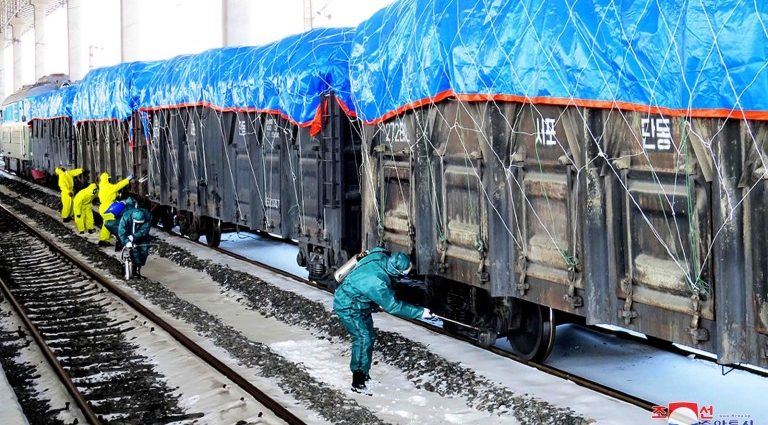For the people of North Korea, 2022 was another difficult year. But as 2023 dawns, glimmers of hope are emerging as the country’s foreign trade with China and Russia begins to resume.
Food security remains the greatest challenge facing the North Korean people. The UN’s World Food Program estimates that 10.7 million people — over 40% of the population — are undernourished.
In March 2022, the UN’s Special Rapporteur for Human Rights in the Democratic People’s Republic of Korea (DPRK) warned that “the most vulnerable segments of the population may be facing hunger and starvation.”
But all aid from the World Food Program ceased by April 2021, while bilateral aid from South Korea has collapsed. Aside from an unknown amount of Chinese aid, North Korea neither requested nor received humanitarian assistance in 2022.
While reliable information has been limited due to Covid-19-related restrictions imposed by the DPRK, scholarly analysis suggests that food insecurity in 2022 may have been the worst since the famine experienced during the 1990s, sparking calls for sanction adjustments for humanitarian purposes.
A central reason for this food insecurity is the DPRK’s strict Covid-19-related restrictions on human mobility. North Korea’s Covid-19 policy first began to shift on May 12, 2022, when the Politburo admitted that “a break was made on the emergency epidemic prevention front.”
By late May, reports of lockdowns, mass testing and temporary quarantine sites were emerging from across North Korea. State media reported over 2.65 million cases of “fever” across the country. In July, the government declared a “maximum” national emergency while locking down the city of Kaesong.

On August 10, 2022, North Korean Leader Kim Jong Un declared “victory” against Covid-19. In September, vaccinations finally began in particularly hard-hit regions, presumably using Chinese vaccines. By early November, a second round of vaccinations was underway, apparently focussing on the border region with China.
These regions have been hit particularly hard by border closures and domestic lockdowns, exacerbated by the war in Ukraine, widespread summer flooding and ongoing multilateral sanctions.
Foreign trade in 2020 dropped to US$8.6 billion, an annual decline of 73.4%, and fell again in 2021 to $7.1 billion, the lowest level on record. Most crucially, exports to China over the first half of 2022 fell a further 75% year-on-year to just $27 million, while imports from China dropped 67% to $380 million.
With a near-collapse of access to foreign currency, the North Korean government adopted various measures designed to extract foreign currency while enhancing state control over markets. Such measures included collecting fees and taxes in foreign currency, encouraging the use of foreign currency in state-run stores and increasing the fees charged to market sellers.
Only in late September 2022 did freight train services from the Chinese border city of Dandong to North Korea’s Sinuiju resume.
Initially, North Korea mostly imported industrial goods, but Chinese customs data shows that imports of medicine and rice in October jumped to their highest levels since 2020. Bilateral trade reached $125.7 million in November 2022, dominated by medicines and food.
By late December 2022, news sources suggested plans to return DPRK laborers to Russia, while reports emerged of North Korean firms planning to resume their contract manufacturing and cross-border trade with China. Such measures would enable the DPRK to secure valuable foreign currency while still limiting incoming travel.
An increase in military confrontation also limited the potential for a resumption of humanitarian assistance, as North Korea conducted over 90 cruise and ballistic missile tests in 2022.
While Kim Jong Un has repeatedly signaled his determination to continue pursuing nuclear weapons, Pyongyang has so far abstained from conducting its long-expected seventh nuclear test, perhaps due to Chinese objections.

But North Korea’s missile program and military assertiveness have had a negative effect on its relationship with South Korea, which had previously been a major source of humanitarian assistance for the North.
The election of new South Korean President Yoon Suk-yeol in May 2022 was part of the escalatory cycle. Yoon resumed large-scale joint military exercises with the United States and has adopted an explicit tit-for-tat strategy in response to the DPRK’s provocations.
In early January 2023, Yoon even expressed concern over the United States’ deterrence efforts, suggesting that Seoul should be included in nuclear weapons “planning, information sharing, exercises and training”, a suggestion that Washington quickly dismissed.
Meanwhile, worrying signs continue to emerge from North Korea. Most recently, with the arrival of North Korea’s spring farming season, it appears that chemical fertilizer is in short supply at this crucial moment in the planting cycle.
With Pyongyang continuing its nuclear weapons program, a hard-line president in Seoul, the ongoing war in Ukraine and intensifying US-China strategic competition, prospects look dim for a resumption of humanitarian assistance to North Korea.
Without sanctions relief or major humanitarian assistance, the best hope for improved livelihoods in North Korea rests with a resumption of border trade with China, accompanied by a return to market-favorable measures at home.
The end of China’s “zero-Covid” measures offers some hope amid the dark clouds that continue to hang over the Korean Peninsula.
Jamie Reilly is Associate Professor of Government and International Relations at the University of Sydney.
This article, republished with permission, was first published by East Asia Forum, which is based out of the Crawford School of Public Policy within the College of Asia and the Pacific at the Australian National University.

